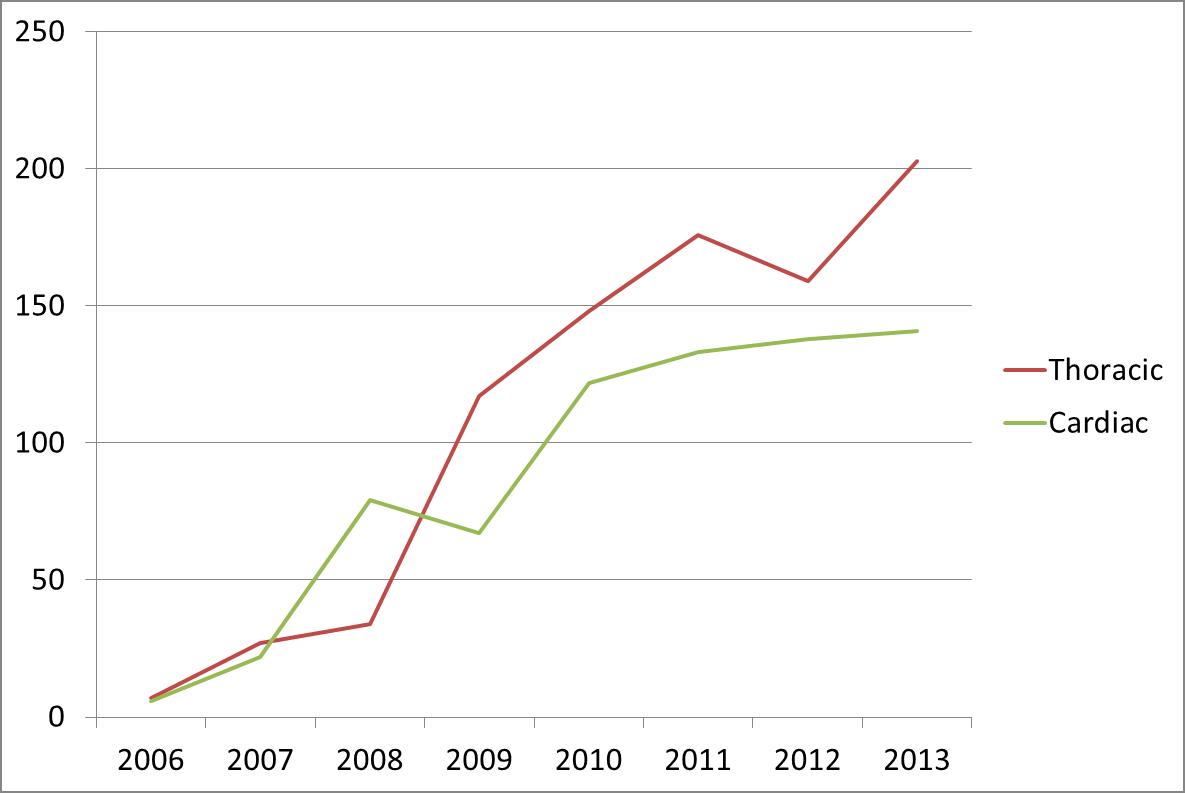초록접수 현황
| 14F-007 | 구연 발표 |
Current trend of robotic thoracic and cardiovascular surgery in Korea
Chang Hyun Kang¹, Na Rae Lee², Samina Park¹, Jinho Choi¹, Jin San Bok¹, Yoo Hwa Hwang¹, Seon Heui Lee², Hyun Joo Lee¹, In Kyu Park¹, Cheong Lim³, Young Tae Kim¹
Department of Thoracic and Cardiovascular Surgery, Seoul National University Hospital¹,
Department of Health Technology Assessment, National Evidence-based Healthcare Collaborating Agency²,
Department of Thoracic and Cardiovascular Surgery, Seoul National University Bundang Hospital³
Background : The aim of this study was to report the current trend of robotic thoracic and cardiovascular surgery in Korea.
Methods : Two types of databases were used in this study. The first database was collected by National Evidence-based Healthcare Collaborating Agency (NECA) between 2006 and 2012, and the second database was collected by Intuitive Surgical Korea (IS-K) from 2010 to 2014. These two databases were merged for the analysis.
Results : A total of 1,766 cases were included in the study. There were 980 cases of thoracic surgery (55%) and 786 cases of cardiac surgery (45%). The main indications for thoracic surgery were esophageal disease in 403 cases (41%), pulmonary disease in 339 cases (35%), and mediastinal disease in 187 cases (19%). The main indications for cardiac surgery were valvular heart disease in 568 cases (72%), atrial septal defect in 128 cases (16%), and ischemic heart disease in 38 cases (5%). The study of annual trend demonstrated that the incidence of esophageal disease and valvular heart disease is increasing; however, the incidence of pulmonary disease is decreasing. Per-hospital analysis from the NECA database demonstrated that robotic thoracic surgery was performed in 16 hospitals and robotic cardiac surgery was performed in 11 hospitals. Three major hospitals performed 74% of the total cases of robotic thoracic surgery and 95% of the total cases of robotic cardiac surgery. Per-region analysis from the IS-K database demonstrated that 66% of robotic thoracic surgeries and 88% of robotic cardiac surgeries were performed in Seoul.
Conclusion : Trend analysis of robotic thoracic and cardiovascular surgery demonstrated a gradual increase in the incidence of robotic surgery especially for esophageal and valvular heart disease. However, centralization of surgical cases to a specific region and hospital was observed.
Methods : Two types of databases were used in this study. The first database was collected by National Evidence-based Healthcare Collaborating Agency (NECA) between 2006 and 2012, and the second database was collected by Intuitive Surgical Korea (IS-K) from 2010 to 2014. These two databases were merged for the analysis.
Results : A total of 1,766 cases were included in the study. There were 980 cases of thoracic surgery (55%) and 786 cases of cardiac surgery (45%). The main indications for thoracic surgery were esophageal disease in 403 cases (41%), pulmonary disease in 339 cases (35%), and mediastinal disease in 187 cases (19%). The main indications for cardiac surgery were valvular heart disease in 568 cases (72%), atrial septal defect in 128 cases (16%), and ischemic heart disease in 38 cases (5%). The study of annual trend demonstrated that the incidence of esophageal disease and valvular heart disease is increasing; however, the incidence of pulmonary disease is decreasing. Per-hospital analysis from the NECA database demonstrated that robotic thoracic surgery was performed in 16 hospitals and robotic cardiac surgery was performed in 11 hospitals. Three major hospitals performed 74% of the total cases of robotic thoracic surgery and 95% of the total cases of robotic cardiac surgery. Per-region analysis from the IS-K database demonstrated that 66% of robotic thoracic surgeries and 88% of robotic cardiac surgeries were performed in Seoul.
Conclusion : Trend analysis of robotic thoracic and cardiovascular surgery demonstrated a gradual increase in the incidence of robotic surgery especially for esophageal and valvular heart disease. However, centralization of surgical cases to a specific region and hospital was observed.

책임저자: 강창현
서울대학교 의과대학 흉부외과학교실
연락처 : 강창현, Tel: 02-2072-3010 , E-mail : chkang@snu.ac.kr




















